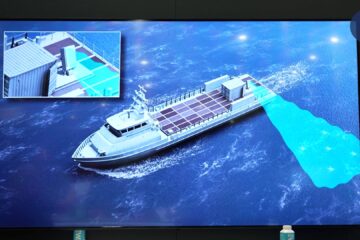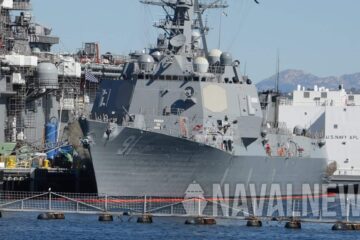On September 6th, the Department of Defense postponed what was expected to be the launch of the US Army’s Long-Range Hypersonic Weapon System (LRHW). This test was scheduled to demonstrate the Army’s Weapon Control System and Battery Operations Center. It was also set to be the first test to be launched from the Army’s transporter-erector-launcher.
“On Sept. 6, the Department planned to conduct a flight test at the Cape Canaveral Space Force Station, Florida, to inform our hypersonic technology development. As a result of pre-flight checks, the test did not occur,” The Office of the Secretary of Defense told Florida Today, which first reported on the postponement. “The Department was able to successfully collect data on the performance of the ground hardware and software that will inform the continued progress toward fielding offensive hypersonic weapons. Delivering hypersonic weapons remains a top priority for the Department.”
The flight test, which is designated Joint Flight Campaign 2 (JFC-2), has been postponed three times so far. It was originally scheduled for late last year, but the missile experienced preflight issues and the test was postponed to early 2023. The test was again postponed from early 2023 to a later date in 2023 due to a battery issue that was discovered before the flight test.
While the program hasn’t suffered a test flight failure since 2022, the delays are hampering fielding efforts as Washington moves fast to catch up with China, which fielded the DF-17, its first hypersonic weapon system, in 2019.
Hypersonic weapon testing woes

The LRHW originates from the Conventional Prompt Strike (CPS), a joint program between the US Army and US Navy. Currently, the CPS program is being run as a Section 804 Middle Tier of Acquisition (MTA) program. Under this acquisition strategy, the program is happening in multiple phases, the first of which seeks to develop and demonstrate a hypersonic, cold-gas launched missile system prototype capability.
According to the Director, Operational Test and Evaluations’ (DOT&E) 2022 annual report, the Navy is the service responsible for developing the Master Test Strategy (MTS) for Phase 1 of the CPS program. The Navy was to conduct five flight tests under a Joint Flight Campaign with the Army. The first test, JFC-1, took place in June 2022 and ended in failure after the missile experienced an in-flight anomaly.
Following the failure, the schedule for the following test, JFC-2, which was to occur in late 2022, was deferred to 2023. Under the Navy’s MST, four more JFC tests have to be carried out before the fourth quarter of 2024 for the completion of Phase 1.
The JFC-2 and 3 flight tests are to be conducted in support of the Army’s LRHW program, with the tests set to utilize the Army Weapon Control System, Battery Operations Center, and prototype transporter-erector-launcher. For the Army to transition LRHW from MTA to a Program of Record (POR), the service must complete three flight tests.
The service also needs to complete these tests for early fielding with the 5th Battalion, 3rd Field Artillery Regiment based out of Joint Base Lewis-McChord, Washington. The unit is assigned to the Army’s 1st Multi-Domain Task Force.
The JFC-4 and 5 flight tests are set to demonstrate the US Navy’s cold-gas launch capability. JFC-4 is scheduled to be carried out from an In-Air Launch test facility using a Box Launcher in the second quarter of 2024. This test is set to demonstrate cold-gas launch capabilities for fielding with the Zumwalt-class.
The JFC-5 is scheduled for the fourth quarter of 2024 and is supposed to be a two-shot flight campaign, meaning the test will likely involve two firings. The test is also scheduled to be a cold-gas launch in support of early fielding on the Zumwalt.
However, all these dates are likely to be pushed back following the recent delays. The program’s testing plans have been pushed back by almost a year and a half. These testing woes impact not only early US Army fielding but also US Navy fielding on the Zumwalt-class and may even impact the Virginia-class.
Now that both JFC-2 and 3 have been delayed significantly, JFC-4 and 5 are likely to be pushed back into FY2025, when JFC-6 is scheduled to occur from the USS Zumwalt and JFC-7 in FY2026 from the USS Michael Mansoor.
About the Conventional Prompt Strike

The Conventional Prompt Strike program is a joint program between the US Navy and US Army, to deliver a long-range hypersonic missile that carries the re-entry called the Common Hypersonic Glide Body (C-HGB). The re-entry vehicle is derived from the Sandia Winged Energy Reentry Vehicle (SWERVE) designed by Sandia National Laboratory.
As the name implies, the C-HGB is a common system utilized by the Navy for its CPS and by the Army for its LRHW. The role of the Navy in the program is the design and development of the C-HGB and two-stage booster, and integration of the C-HGB with the booster to create an All-Up Round (AUR). The Army is responsible for the manufacturing of the C-HGB.
The Army plans to field the first LRHW battery in 2023 with a second in 2025 and third battery following in 2027. The main parts of the battery will be made up of four Transport Erector Launchers (TEL), each equipped with two missiles and a Battery Operations Center (BOC). The LRHW batteries will be deployed as a part of the Army’s new Multi Domain Task Force. There the batteries will fall under a Strategic Fires Battalion, alongside a HIMARS Battery and a Mid-Range Capability Battery.
The Navy expects the first deployment of the CPS-equipped USS Zumwalt (DDG-1000) to occur in the fourth quarter of 2025, followed by the USS Michael Mansoor (DDG-1001) in the fourth quarter of 2026, and the last ship in the class, USS Lyndon Johnson (DDG-1002) in the fourth quarter of 2027.
Fielding on the Virginia-class is expected to take place in 2029 on one of the Block V submarines, which will be equipped with the Virginia Payload Module (VPM).






